Related Research Articles
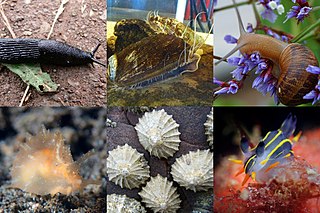
Gastropods, commonly known as slugs and snails, belong to a large taxonomic class of invertebrates within the phylum Mollusca called Gastropoda.
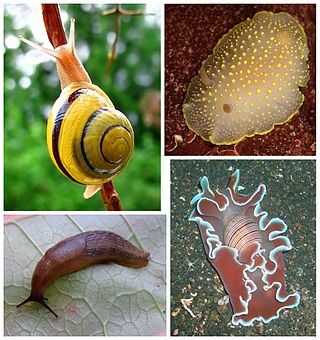
Heterobranchia, the heterobranchs, is a taxonomic clade of snails and slugs, which includes marine, aquatic and terrestrial gastropod mollusks.

Caenogastropoda is a taxonomic subclass of molluscs in the class Gastropoda. It is a large diverse group which are mostly sea snails and other marine gastropod mollusks, but also includes some freshwater snails and some land snails. The subclass is the most diverse and ecologically successful of the gastropods.

Hypsogastropoda is a clade containing marine gastropods within the clade Caenogastropoda.

Conoidea is a superfamily of predatory sea snails, marine gastropod mollusks within the suborder Hypsogastropoda. This superfamily is a very large group of marine mollusks, estimated at 340 recent valid genera and subgenera, and considered by one authority to contain 4,000 named living species.

Helicoidea is a taxonomic superfamily of air-breathing land snails, terrestrial pulmonate gastropod mollusks in the clade Stylommatophora.

Polyceroidea is a taxonomic superfamily of sea slugs, specifically dorid nudibranchs, marine gastropod mollusks in the clade Doridacea.
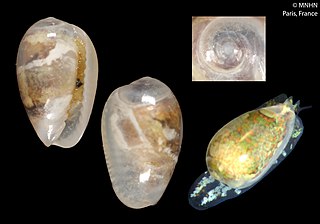
Cystiscidae is a taxonomic family of minute sea snails, marine gastropod mollusks or micromollusks.
The taxonomy of the Gastropoda as it was revised in 2005 by Philippe Bouchet and Jean-Pierre Rocroi is a system for the scientific classification of gastropod mollusks. The paper setting out this taxonomy was published in the journal Malacologia. The system encompasses both living and extinct groups, as well as some fossils whose classification as gastropods is uncertain.

Eucyclidae is a family of gastropods in the superfamily Seguenzioidea.
Nudipleura are a clade of sea snails and sea slugs, marine gastropod mollusks within the large clade Heterobranchia.
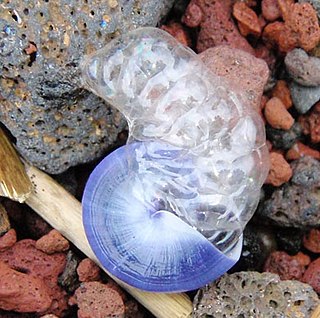
The Ptenoglossa is an informal taxonomic group of sea snails. This group was considered paraphyletic or polyphyletic by Ponder and Lindberg (1997) in their classification of gastropod molluscs.

The Limacoidei is a taxonomic infraorder of air-breathing land snails, semislugs and slugs, terrestrial pulmonate gastropod molluscs in the suborder Helicina

The Dexiarchia are a suborder of sea slugs, shell-less marine gastropod molluscs in the order Nudibranchia. This classification is based on the study by Schrödl et al., published in 2001, who recognized within this clade two clades Pseudoeuctenidiacea and Cladobranchia.
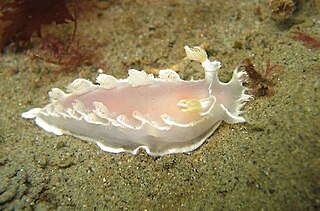
The Cladobranchia are a taxonomic clade of nudibranchs, sea slugs, marine gastropod molluscs in the clade Dexiarchia.

The Clausilioidea are a superfamily of air-breathing land snails and slugs, terrestrial gastropod mollusks in the informal group Sigmurethra.
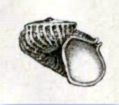
Scissurelloidea is a taxonomic superfamily of minute sea snails, marine gastropod mollusks or micromollusks in the subclass Vetigastropoda.

Velutinoidea is a superfamily of sea snails, marine gastropod molluscs in the clade Littorinimorpha.

Triphoroidea is a superfamily of minute sea snails, marine gastropod molluscs or micromolluscs within the informal group Ptenoglossa.
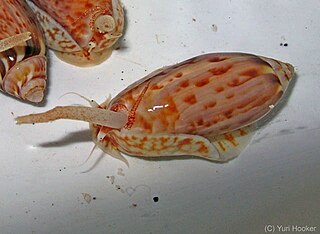
Olivoidea is a taxonomic superfamily of minute to medium-large predatory sea snails, marine gastropod mollusks in the order Neogastropoda.
References
- ↑ Popenoe, W. P.; Saul, L. R. (1987). "Evolution and Classification of the Late Cretaceous-Early Tertiary Gastropod Perissitys" (PDF). Contributions in Science. 380. Natural History Museum of Los Angeles County: 1–37. doi:10.5962/p.208124. S2CID 134482355.
- ↑ Bouchet, P. & Rocroi, J.-P. (2005). "Classification and Nomenclator of Gastropod Families". Malacologia. 47 (1–2).